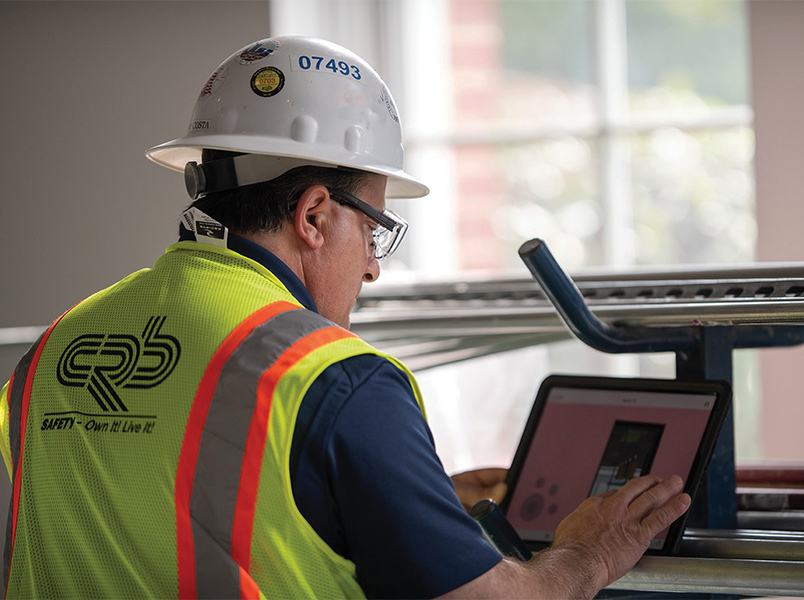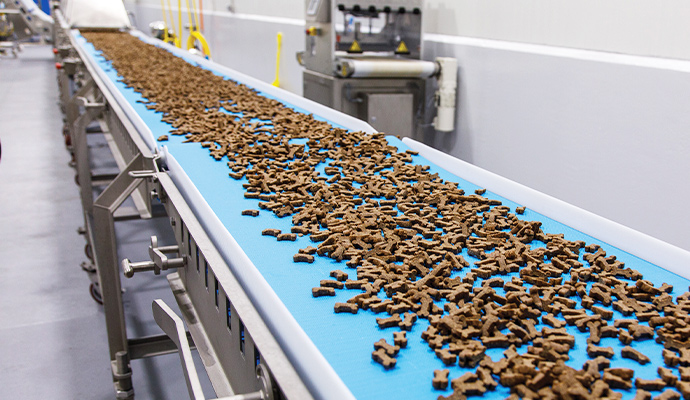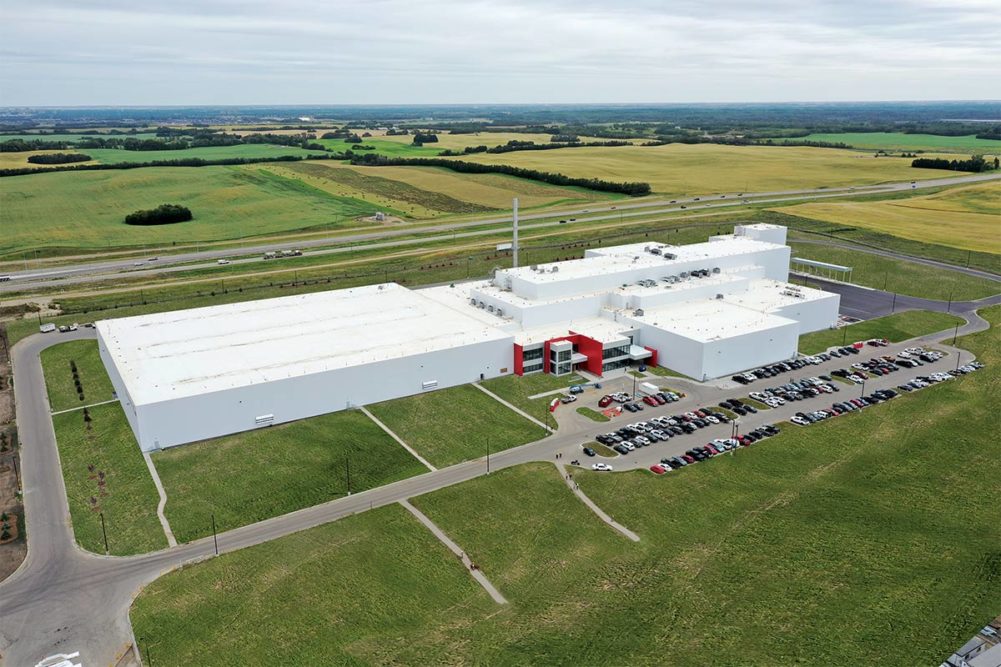This article was published in the June 2021 issue of Pet Food Processing. Read it and other articles from this issue in our June 2021 digital edition.
There are always many considerations that go into designing a new plant for pet food or treat manufacturers, and the COVID-19 pandemic added even more things that need to be taken into account.
So, in addition to thinking about food safety, the types of product being produced and the expansion possibilities at a plant, now manufacturers and those building and designing these facilities must consider changes to the offices, employee spaces, and even entrances and exits that create a safer and more comfortable environment for workers.
Zach Becks, manager, architecture and engineering (A&E) integration, food and beverage, Gray Construction, Lexington, Ky., noted design is key in determining the safety and quality of the food produced in a pet food operation.
“The basis of a facility program or layout is in the understanding of people, product and waste movement,” said Zach Becks, Gray Construction.
“We collaborate with our pet food customers on design aspects to ensure the company’s strict standards for quality, food safety and sanitation are met,” he said. “While there are many hygienic design considerations when building a pet food facility, the basis of a facility program or layout is in the understanding of people, product and waste movement. By understanding these, hygienic zoning and adjacencies can be established in order to reduce the risk of product contamination.”
These movements also help to streamline operations. A well-designed facility allows processors to produce great food efficiently and maintain a clean environment to reduce the chances of recalls.
Joe McCarthy, chief supply officer, Champion Petfoods, Edmonton, Alberta, noted food safety, quality and employee health are at the core of its plant designs, and that’s something that will never change.
“When we built our DogStar kitchen in Kentucky in 2016 and our NorthStar kitchen in Alberta in 2019, we set out to build facilities that exceeded standards set in the pet food industry,” he said. “Fortunately, the result is kitchens that exceed many standards in the human food industry as well.”
Both facilities were purpose-built and custom-designed specifically for Champion Petfoods’ unique recipes, which include fresh and raw ingredients.
“We intentionally located them in agricultural heartlands so they can be closer to many of the sources of ingredients we use,” McCarthy said.
What’s trending
Tyler Cundiff, president, food and beverage, Gray Inc., said through the company’s robust offerings — which include operational improvements, construction, extensive engineering, automation, systems integration and equipment manufacturing — he is seeing above-average activity in the food and beverage industry with a focus on speed to market; upgrades to meet CDC guidelines related to COVID-19; automation, AI and robotics; and availability of cold storage space.
 An integrated design and construction team can work seamlessly to balance an owners’ wants and needs, while still providing cost-effective and efficient solutions. (Source: Tuffy’s Pet Foods, Inc.)
An integrated design and construction team can work seamlessly to balance an owners’ wants and needs, while still providing cost-effective and efficient solutions. (Source: Tuffy’s Pet Foods, Inc.)“Additionally, many of our food and beverage projects, including pet food facilities, are being driven by food safety, quality control, Clean-in-Place (CIP) solutions, high-level automation, data acquisition and employee welfare,” he said. “They also require flexible design concepts to meet ever-changing product and market demands and include an increased focus on hygiene, sanitation, and separation of raw ingredients and finished products.”
For instance, Petsource by Scoular recently chose Gray to partner on the company’s first manufacturing venture into pet food. The facility produces safe, high-quality, high-protein ingredients for pet food manufacturers and includes a warehouse, cold storage rooms for raw meat, freeze-dryers and clean rooms.
Gray was also selected to provide robust service offerings including strategy, operational improvements, design, engineering, automation and controls, and construction on two projects for Nestlé Purina PetCare: the company’s first new facility since 1975 in Williamsburg Township, Ohio, and the renovation of an old brewery into a world-class pet food facility in Eden, N.C. They will be completed in 2022 and 2023, respectively.
These facilities are being built with new design principles growing in importance in light of the COVID-19 pandemic, such as air filtration and ventilation design, as well as the concept of creating separation between people within the facility, whether through physical space or the addition of barriers between workstations. Lastly, more touchless design elements are being integrated into the facility to increase the use of new health and hygienic technologies.
“We already have a precedent for judicious design in spaces where employees interact,” Cundiff said. “The COVID-19 pandemic has taken these measures to a new level. We are implementing facility design strategies to not only mitigate the presumed risks of an operation, but we’re now adding another layer of stringent design principles to mitigate this pandemic and potential future pandemics. The design of these areas has changed to better meet sanitation and safety goals.”
He explained the first barrier of defense is a deliberate site plan, which can help mitigate outside risk, followed by design elements within the facility that help prevent any risks from entering the building.
“Material selection also plays an important role in maintenance and sanitation and can include anything from the material selection of the building’s structure and skin, all the way to the interior finishes or even furniture finishes,” said Tyler Cundiff, Gray Inc.
“The careful consideration of the circulation of employees can also help support maintenance and sanitation protocols,” Cundiff said. “Material selection also plays an important role in maintenance and sanitation and can include anything from the material selection of the building’s structure and skin, all the way to the interior finishes or even furniture finishes.”
Tom Rychlewski, food and beverage core team leader, CRB Group, Kansas City, Mo., has seen more pet food manufacturers gravitate toward cleanable equipment in their plants, and giving more thought overall to food safety in the plant designs.
He noted hygienic zoning is a design approach focused on understanding the manufacturing process, the food safety risks associated, and corresponding design needs of the spaces to support mitigating these risks.
Since COVID-19, he has seen more thought given to segregating different lines — so one can be cleaned while the other still operates — and more designs helping people move in a plant in a way that they don’t contaminate the product. There have also been plexiglass separators installed between workers and requirements around masks, temperature taking and sanitization.
Sam Thurber, senior product manager, SSOE Group, Toledo, Ohio, noted continued pressure to increase speed of delivery of projects, which is not new.
“In other words, clients want more, faster, and now,” he said. “We have been able to accomplish this by using lean project delivery methods, which helps eliminate waste and allows for schedule compression.”
 Tuffy’s Treat Company leveraged mobile equipment in their Delano, Minn. facility to allow operators to quickly add or remove equipment from the conveyance system. (Source: Tuffy’s Pet Foods, Inc.)
Tuffy’s Treat Company leveraged mobile equipment in their Delano, Minn. facility to allow operators to quickly add or remove equipment from the conveyance system. (Source: Tuffy’s Pet Foods, Inc.)
Another aspect is “early purchase” of construction material. Items that traditionally were short lead-time, or off-the-shelf, are taking weeks or even months now. If you know you need something later, buying it now is a safer bet, Thurber said.
Design-build philosophy
Another trend that has gained prominence in recent years concerns design-build, a construction concept where a project is built while it is still being designed rather than determining every detail from the beginning.
Gray has a deep history in design-build with Jim Gray, former president and chief executive officer and current chairman of the board, being one of the founding fathers of the Design-Build Institute of America.
“The design-build delivery method offers significant advantages to food and beverage manufacturers, including pet food processors, since it enables projects to be delivered faster and more cost-effectively with clear quality standards all fully integrated within a highly collaborative team,” Cundiff said. “Building on this model since the 1970s, today we execute nearly all our food and pet food projects with variations of this model.
“In addition to design, building engineering and construction, our customers want and need a similar collaborative approach as it relates to process and packaging engineering, controls integration, automation and even equipment prefabrication,” Cundiff said. “As a pioneer in this industry and in design-build, Gray has continued to evolve to meet our customers’ needs and provide these services with a robust team of technical in-house resources along with industry partners to deliver a more comprehensive scope that is sometimes referenced as EPC (Engineer, Procure, Construct) or turnkey.”
As an example, Gray’s successful design-build of Champion Petfoods’ DogStar Kitchens is something that both companies credit to the EPCM [engineering, procurement and construction management] model.
CRB Group uses the design-build process in most cases today, including its most recent plant designs for Simmons Pet Food and Freshpet.
“I whole-heartedly believe this is the way of the future,” Rychlewski said. “That is what is required to go fast, and most clients call us because they have an immediate demand that they need to meet. Though it’s nice to design a facility and work out all the bugs upfront, and then start to build, there is a cost of speed to market.”
In order to accomplish a savvy design for a pet food processing plant, the key is to listen to what the processor wants to achieve. Understanding manufacturing operations and goals, coupled with applying design expertise — including the planning for future process that allows room for growth from both a product and employee perspective — allows processors to be confident in their plant designs.
Find more articles related to pet food and ingredient facilities.





